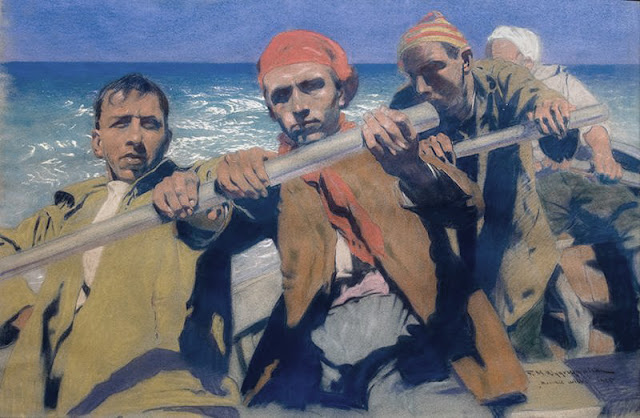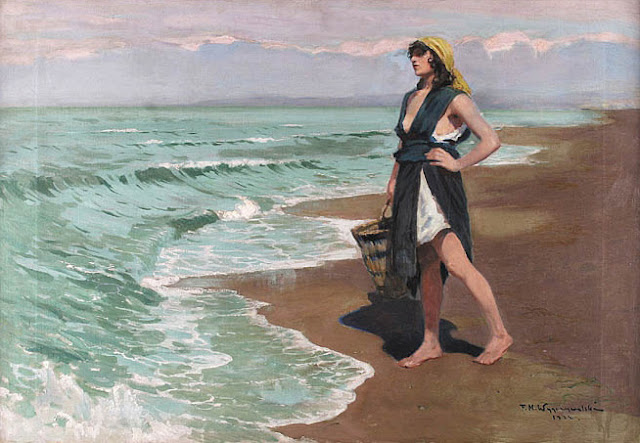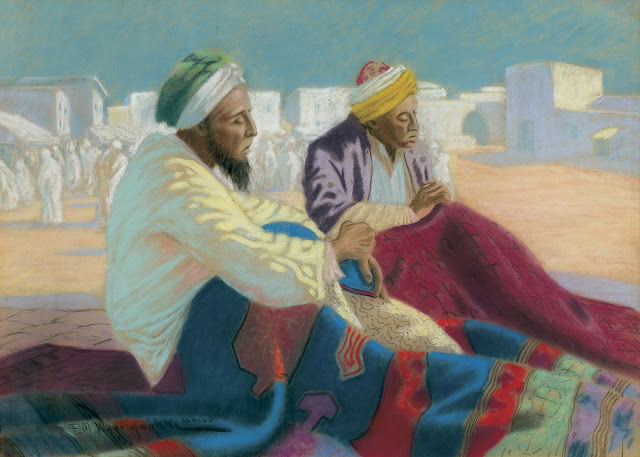In 1900, he decided to settle in Rome and married a local woman named Rosa Imassa. His studies there consisted largely of copying the Old Masters, but he also created landscapes and nudes. Later, he provided illustrations for the Polish travel magazine, Wedrowiec (The Wanderer), as well as magazines in Germany and Russia.
In 1906, he visited Egypt, creating numerous paintings and sketches for later use. When he came back to Poland in 1908, he lived in Lwów, where he had been commissioned to paint murals at the Chamber of Commerce and Industry. He also did some stage designs. During Worls War I, he moved to Rostov-on-Don and became a drawing professor. He returned to Lwów when the war was over.
He was a frequent participant in exhibitions, but his first personal showing came only in 1932, at the local "Society of Friends of the Fine Arts". During this period, his major work was a series of fourteen paintings, depicting the history of dance, for the sanatorium at the health resort in Krynica-Zdrój. For most of his later life, he maintained his own art salon in Lwów called, in German, "Kunstaustellung" (art exhibit). During the post-war depression, many upper-class people sold their paintings there; often entire collections.
In July 1944, at the approach of the Red Army, he was forced to flee Lwów, leaving all of his possessions behind. He found refuge at a tenement house in Rzeszów, but died only a few months later, from a stroke; possibly the result of an injury he suffered while fleeing. He was buried at the local cemetery, but his grave has not survived.
His works may be seen at numerous museums throughout Poland and Ukraine. In 2012, the city of Lódz organised an exhibition called "Between Capri and Lviv - painting travels by Feliks Michał Wygrzywalski." The following year, the National Maritime Museum, Gdansk, presented some of his works as part of a series on Polish artists and the sea.
For earlier works see part 1 also. This is part 2 of a 5-part series on the works of Feliks Michał Wygrzywalski:
Note: Wygrzywalski often painted variations of a painting that look very similar but have minor differences.
 |
| 1923 Capri oil on canvas 50.5 x 80.5 cm |
 |
| 1923 Capri oil (details not found) |
 |
| 1923 From Capri motifs oil on canvas 78 x 96.5 cm |
 |
| 1923 The fishing port of Capri oil on plywood 31 x 43.5 cm |
 |
| c1923 At the Arab Souk oil on cardboard Private Collection |
 |
| c1923 Lido oil on canvas 45.5 x 61 cm |
 |
| c1923 With the Sun - Capri oil on plywood 22 x 32 cm |
 |
| 1924 A Nun reading by candlelight oil on canvas 86 x 68 cm |
 |
| 1924 In the Port oil on canvas 49.7 x 80 cm |
 |
| 1925 Arab prayer oil on plywood 35 x 49 cm |
 |
| 1925 Army of Knights pastel on card 71 x 54 cm |
 |
| 1925 Big Catch oil on canvas 64 x 93 cm |
 |
| 1925 Branki oil on canvas 81.5 x 109.5 cm |
 |
| 1925 Burlaks oil on canvas 91 x 103 cm National Museum, Warsaw |
 |
| 1925 Cinderella pastel on paper 63 x 48 cm |
 |
| 1925 Dancing lesson oil on canvas 50 x 70 cm |
%201%20oil%20on%20canvas%2056%20x%20173%20cm.jpg) |
| 1925 Design of a decorative architectural panel oil on canvas 56 x 173 cm |
%202%20oil%20on%20canvas.jpg) |
| 1925 Design of a decorative architectural panel detail |
 |
| 1925 Doctor Shapiro watercolour and gouache 43.8 x 32.4 cm |
 |
| 1925 Kainit Stebnicki colour lithograph poster |
 |
| 1925 Sea Wolves pastel on paper 71.2 x 108.5 cm |
 |
| 1925 The Trevi Fountain, Rome oil on plywood 22 x 31.5 cm |
 |
| c1925 Girl at the seashore oil on canvas 71 x 102 cm |
 |
| 1926 Nude by the sea (details not found) |
 |
| c1929 Capri oil on canvas 51 x 80 cm |
 |
| 1930 Long live Caprese, ok oil on canvas 52 x 72 cm |
 |
| 1930 On the beach oil on canvas 56 x 65.5 cm |
 |
| 1930 The rug weavers pastel on paper 47 x 66 cm |
 |
| c1930 Prayer in the desert oil on canvas 50.4 x 70.4 cm |
 |
| 1931 Boat on the open sea oil on canvas 44 x 90 cm |
%20pastel%20on%20paper%2075%20x%2051%20cm.jpg) |
| 1931 Defender of Islam (self-portrait) pastel on paper 75 x 51 cm |
 |
| 1931 Sunday on a donkey oil on plywood 32 x 44 cm |
.jpg) |
| 1931 The rocky coast of Capri oil on plywood (size not given) |
 |
| c1931 In the garden oil on canvas 73 x 100 cm |
 |
| before 1932 Lido in the Autumn oil on plywood 22 x 32 cm |
.jpg) |
| 1932 Sea Waves (Capri) details not given National Maritime Museum, Gdansk |
 |
| 1932 The Survivors oil on canvas 63 x 88 cm |
 |
| 1934 Arab women repairing a carpet watercolour on cardboard 49 x 88 cm |
.jpg) |
| 1934 Baltic oil on plywood (size not found) |
 |
| c1935 Courtship oil on canvas 55.5 x 79 cm |


















%20National%20Museum%20in%20Krakow.jpg)






















